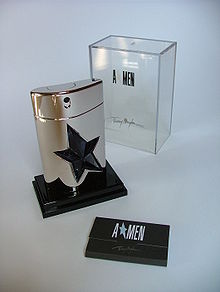
A gourmand fragrance is a perfume consisting primarily of synthetic edible (gourmand) notes, such as honey, chocolate, vanilla or candy.[1][2] These top and middle notes may be blended with non-edible base notes such as patchouli or musk. They have been described as olfactory desserts.[3] They are also called "foodie" fragrances and can be both feminine and masculine.[1]
Thierry Mugler's Angel, launched in 1992, is credited as the first modern gourmand scent.[4][5] Additional examples include Mugler's A*Men, Lolita Lempicka's Lolita Lempicka and Au Masculin, Hanae Mori's Butterfly, Calvin Klein's Euphoria, Burberry's Brit for Men, Rochas' Rochas Man, Chopard's Wish and Viktor & Rolf's Antidote.
The gourmand trend has steadily increased in popularity since 1992, but is not a new concept. In 1956, Edmond Roudnitska created Diorissimo to counter the contemporary preference for heavy and sweet notes which are common in gourmand perfumes.[6]
As the beauty market has evolved, gourmand scents have been attached to more than just sweetness. Perfumers created perfumes with nouvelle or even bizarre notes, such as lobster and pizza.[7]
Most gourmand scents, such as those in the form of bath products, perfume or cologne, are not intended for human consumption. Other gourmand scents are not only scented but flavoured, such as Amoretti's line of products,[8] or Jessica Simpson's discontinued Dessert Treats.[9] These scented products include other forms such as lip glosses, dusting powders and lotions.[10]
Gourmand is considered a subcategory of the modern family of fragrance.[11] Gourmands may also work in combination with the fruity family of fragrance.
- ^ a b Vosnaki, Elena. "Lure of Gourmand Fragrances: Delicious Indulgences", Fragrantica.com Retrieved on 24 January 2013.
- ^ Edwards, Michael. Fragrances of the World "Helpful Scent Guide" Archived 2014-02-01 at the Wayback Machine ThePoshPeasant.com
- ^ "Olfactory Desserts : On Gourmand Fragrances « Bois de Jasmin". Boisdejasmin.com. 2011-08-24. Retrieved 2014-02-22.
- ^ Wischhover, Cheryl. "Thierry Mugler's Angel Perfume Celebrates 20 Years in the US: A Look Back at the Scent and the Fashion Behind It". Fashionista. Retrieved 2014-02-22.
- ^ Wilson, Eric (2010-04-30). "Thierry Mugler, a Designer Transformed". The New York Times. ISSN 0362-4331. Retrieved 2018-05-30.
- ^ Robin. Christian Dior Diorissimo ~ fragrance review Nstperfume.com 2005/04/18
- ^ "Gourmand Perfume Definition: the Secret of Smelling Edible and Delicious (2020 Update)". sniffantasia.com.
- ^ "Amoretti® Ingredients and Flavors | Products". Amoretti.com. Archived from the original on 2014-02-02. Retrieved 2014-02-22.
- ^ "Dessert Treats Rock". Retrieved 2014-02-22.
- ^ "The 27 Best Beauty Products Fashionista Editors Tried in December". Fashionista. Retrieved 2023-08-22.
- ^ The Perfumed Court: Fragrance families Archived February 2, 2014, at the Wayback Machine